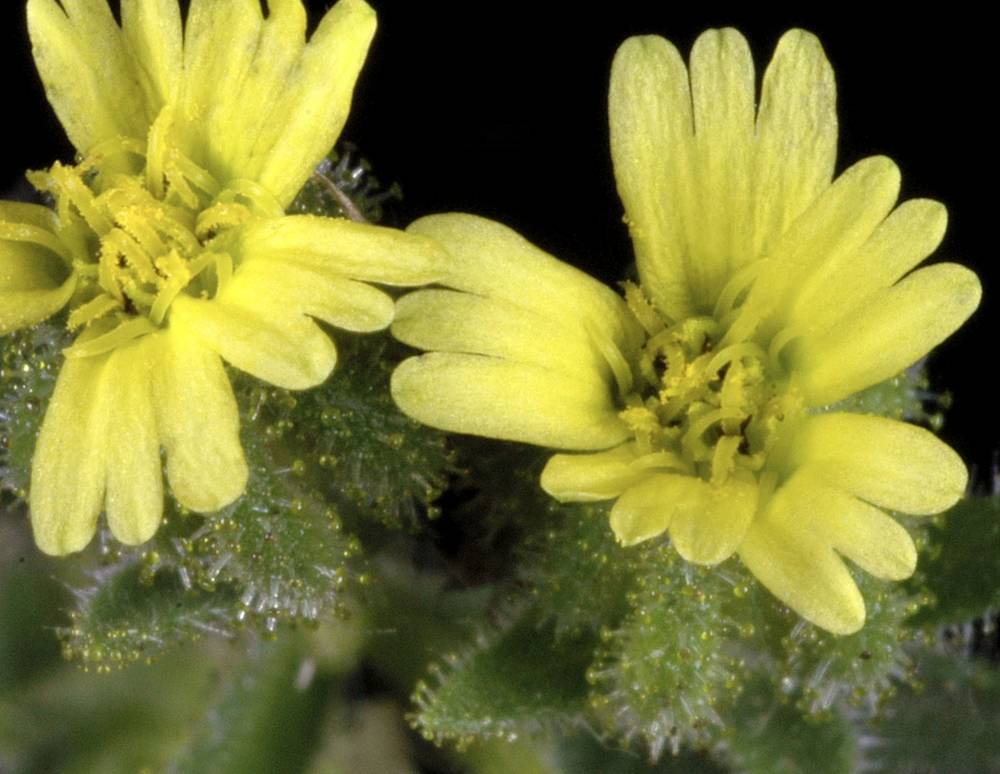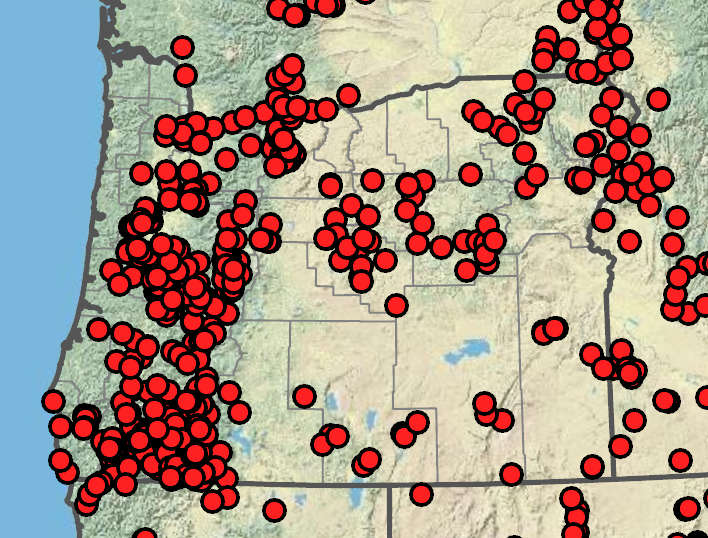Madia gracilis
Madia glomerata
common tarweed, grassy tarweed, gumweed, slender tarweed
cluster tarweed, mountain tarweed
proximally pilose to hirsute, distally glandular-pubescent;
glands yellowish, purple, or black;
lateral branches seldom surpassing main stems.
proximally villous to hispid, distally glandular-pubescent;
glands yellowish or black;
lateral branches sometimes surpassing main stems.
linear to oblong, 1–10(15) cm × 1–8(10) mm.
linear to linear-lanceolate, 2–10 cm × 2–7 mm.
open; panicle- or raceme-like arrays, rarely heads congested.
usually crowded glomerules, sometimes corymb- or panicle-like arrays.
depressed-globose to urceolate, 5–10 mm.
narrowly ovoid or ellipsoid, 5.5–9 mm.
3–10;
corollas lemon-yellow or greenish yellow;
rays 1.5–8 mm.
0–3;
corollas greenish yellow to purplish;
rays 1–3 mm.
2–16+; bisexual, fertile;
corollas 2.5–5 mm, pubescent;
anthers ± dark purple;
ovaries developing;
walls becoming dark; rigid.
1–5(12); bisexual, fertile;
corollas 3–4.5 mm, pubescent;
anthers ± dark purple;
ovaries developing;
walls becoming dark; rigid.
sometimes hirsute, finely or coarsely glandular-pubescent;
glands yellowish, purple, or black;
tips erect or somewhat reflexed; flat.
± pilose and glandular-pubescent;
glands yellowish or black;
tips erect or reflexed; flat.
not showy.
not showy.
connate ? ½ their lengths.
distinct.
compressed; black, purple, or mottled; dull;
compressed; black; dull, not beaked.
not beaked.
similar to ray fruits.
similar to ray fruits.
=32, 48.
=28.
Madia gracilis
Madia glomerata
Open or partially shaded slopes or flats in grasslands, meadows, shrublands, forests, disturbed areas, streambanks. Flowering May–Aug. 0–2100 m. All ecoregions. CA, ID, NV, WA; north to British Columbia, northeast to MT, southeast to UT, south to Mexico. Native.
Madia gracilis often co-occurs with M. sativa. The two species are easily confused because of morphological similarities and inherent variation within both, especially when presented with only ill-prepared or incomplete herbarium material. Despite the tendency of M. gracilis to flower earlier than M. sativa, the two species are partially interfertile (Clausen 1951); hybridization may explain the difficulty of identifying some individuals.
Openings in grasslands, meadows, swales, shrublands, forests, edges of marshes, lakes, or watercourses, disturbed areas. Flowering Jun–Sep. 50–2500 m. All ecoregions except Est. CA, ID, NV, WA; north to AK, northeast to Quebec, east to ME, southeast to NM. Native.
Madia glomerata has the most extensive North American distribution of any species in Madiinae.
Bruce Baldwin, Gerald Carr
Bruce Baldwin, Gerald Carr
- Local floras:
BC,
CA,
OR,
WA
- Local Web sites:
CalFlora,
CalPhotos,
Flora NW,
PNW Herbaria,
Turner Photog.
WildflowerSearch
iNaturalist (observations)
USDA Plants Database
- LBJ Wildflower Center
- SEINet
- Plants of the World Online
- Encyclopedia of Life
- Wikipedia
- Google Image Search
- Local floras:
BC,
CA,
OR,
WA
- Local Web sites:
CalFlora,
CalPhotos,
Flora NW,
PNW Herbaria,
Turner Photog.
WildflowerSearch
iNaturalist (observations)
USDA Plants Database
- LBJ Wildflower Center
- SEINet
- Plants of the World Online
- Encyclopedia of Life
- Wikipedia
- Google Image Search





